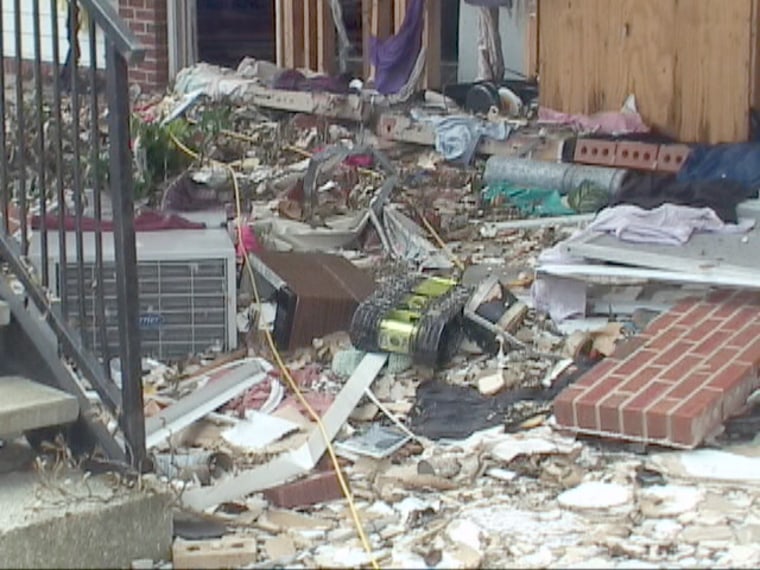In the search for survivors of Hurricane Katrina, the little robot accompanying Florida Task Force 3 was a potential lifesaver — thanks to what it didn't find.
The VGTV Xtreme robot's service in Biloxi, Miss., illustrates how experimental high-tech tools are blending in with the traditional methods for disaster relief, and why such tools are likely to become more widespread in future disaster relief efforts.
And it's not just hardware: Katrina has sparked the development of software tools such as a meta-search engine for survivor lists, and interactive maps that match the needy with what's needed.
The problems with the response to Katrina's devastation show that the technologies related to disaster relief — ranging from communications to rapid-response transportation to search-and-rescue techniques — are sorely in need of an upgrade, said Lois Clark McCoy of the National Institute for Urban Search and Rescue.
"It does no good to shoot this group of sitting ducks and put in a new batch of sitting ducks," McCoy said, referring to the political finger-pointing already well under way. "The problem is not the people, the problem is the system. We have to redesign the system for catastrophic events."
Saving the rescuers
Among the innovations are gadgets that would allow first responders to deal with the aftermath of a catastrophe while limiting their exposure to risk themselves. And that's where the robot comes in.
Florida Task Force 3 is one of the many teams of firefighters, paramedics and law-enforcement officials from several states that have been sweeping through the disaster area looking for survivors or remains. Sometimes, the buildings to be searched are judged to be so unstable that they're not safe to be searched by humans.
"The big thing that the robots bring to the table is that they allow us to gather information without danger to the lives of the rescuers," explained Mark Micire, a technical search specialist with the task force who also owns a robotics company.
On two occasions during the task force's search through Biloxi, that's exactly how Micire's video-equipped mini-robot was used. Micire was particularly proud of how the VGTV Xtreme was used to search a ruined apartment building.
"We were able to go from the front door to the back door and essentially clear the building, and show that there was no one there," he said.
That allowed the team to move on and check other areas for survivors.
"Our team had five lives saved ... which is pretty amazing," Micire said. "For all of the darkness and gloom that's been cast over the entire disaster, when we demobilized, most of us were walking away feeling like we at least made a difference for five families."
Managing the information
Across the country, groups of computer programmers are also feeling as if they're making a difference, even though they may be hundreds or thousands of miles away from the devastation. Several efforts are drawing upon information technology experts spread out from North Carolina to California and Washington state.
One effort makes it possible for you to type in information about missing people, and have that information matched up with multiple databases of Katrina survivors. The online "Missing Persons Center" is being provided by the San Diego Supercomputer Center, AudienceCentral and the National Institute for Urban Search and Rescue.
"With the ability to tie all the database together, through XML and other new technologies, this seems like an advancement that's really going to help in situations like this," said Geoffrey Baron, who works in customer support at AudienceCentral, based in Bellingham, Wash. "The big danger is running multiple databases, and having isolated databases where people are just left in limbo."
The San Diego Supercomputer Center also is involved in an even more ambitious meta-search project called KatrinaSafe.com, which is being put together with assistance from the Red Cross and a variety of corporate sponsors (including Microsoft, a partner in the MSNBC joint venture).
Greg Lund, a spokesman for the center, noted that various organizations are offering at least 30 "safe lists" for survivors and their family members. "Each list is a little bit different, so the challenge is to make enough data points to accurately take the best of all those lists," he told MSNBC.com.
Matching up survivors and resources
Other projects focus on taking satellite imagery of the disaster zone and overlaying virtual "pushpins" that mark the location and the needs of survivors on the scene, in real time. Such a system was spearheaded by North Carolina-based Autonomechs and the search-and-rescue institute.
In the first days after the disaster, the U.S. Coast Guard used the satellite overlay system to target its rescue missions. A follow-up project is now being planned at the San Diego Supercomputer Center with assistance from San Diego State University's Immersive Visualization Center.
Autonomechs' Tim Murphy told MSNBC.com that he'd like to see such mapping interfaces used to put survivors directly in touch with resources. To that end, he's trying to arrange donations of satellite-based Internet terminals that could be sent to the disaster zone for use by the various relief agencies as well as by survivors.
"We need some way of being able to get resources that people are more than happy to offer up out to the field faster," Murphy said. "The Internet, which is obviously built by the community that uses it, has the capability of offering so many resources that FEMA currently doesn't have the capability to keep track of."
Murphy pointed to the eBay auction site as an example of what he was talking about.
"You have people who have stuff, and you have people who want stuff, and they're able to meet online," he observed. "There's no reason why we shouldn't be able to do that."
